Stockholm’s Tio Tretton Library Gives Tweens a Space of Their Own
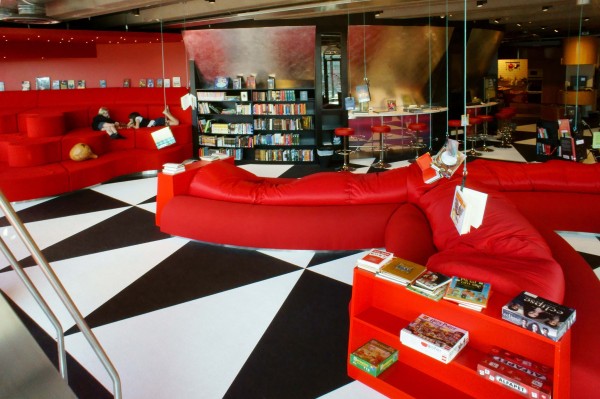
Tio Tretton's multi-layered design offers tweens places to read,
craft, cook, use technology, or just hang out.
At a unique library space in Stockholm, Sweden, the only patrons who can come through the doors are children between the ages of 10 and 13. No parents. No teachers. Just tweens. This age group often feels too old for children’s sections that are heavy on picture books but is not yet ready for full-on young adult literature, says Amanda Stenberg, an educator who works at the library.
TioTretton—translation, “Ten Thirteen”—makes tweens feel at home while also providing some distance from the grownups who shape their lives. “Our goal it that every visitor can feel like they can shape their visit that day,” says Stenberg. While many libraries may strive to validate tweens in this manner, TioTretton reflects this ambition in every aspect of its design and service. At the door, kids must remove their shoes before stepping over a line on the floor that only 10- to 13-year-olds can cross. “Here you do not need to do anything more than take off your shoes,” TioTretton’s website explains below a photo of a snoozing, stocking-footed girl stretched out on a red sofa and surrounded by books.
Tweens lounging in Tio Tretton's hammock-like windowseats.
Photo credit: Andreas Burmester.
In tune with this no-rule environment, architect Ricardo Ortiz aimed to “create a place where a child could find his or her own mood.” Depending on a young patron’s inclination, that could mean nestling in one of several pods of red cushioned furniture, each with subtle design variations to suit different temperaments, and selecting a book from a nearby shelf or one suspended from an overhead coil.
It could involve making ravioli from scratch in the library kitchen and browsing through the cookbooks, putting together a costume with one of the sewing machines and leafing through books about textiles, making music, or sharing a broadcast or film made on one of the library’s iPads. Located on the second floor of the Kulturhuset building, a large cultural center in Stockholm that is also home to other library spaces, TioTretton opened in the fall of 2011. It was the brainchild of Katti Hoflin, the former director of or Stockholm’s libraries, who saw that kids this age weren’t interested in the city’s existing library options. “Instead of saying, ‘How can we change kids to get them to come to the library?’ she said, ‘How can we change?’” according to Stenberg.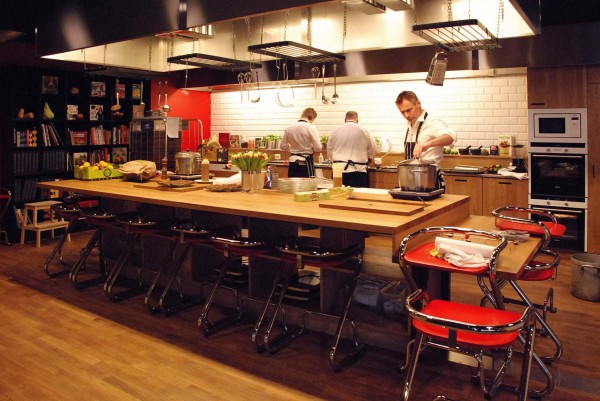
In the Tio Tretton kitchen, librarians and kids cook together,
eat, and share stories at the large kitchen table.
To discover what this group wanted in a library, Hoflin initiated a pre-study, carried out by Ylva Ågren, of Stockholm University’s Centre for the Studies of Children´s Culture, and Lena Thunberg, now an educator at TioTretton. The poll asked 125 Stockholm tweens about “their thoughts concerning reading, what they liked to do in their free time, and about their dream space,” Stenberg says.
“They wanted a place of their own,” the study revealed. Stenberg adds that kids this age are “really used to always being told by grownups what’s right and what’s wrong.” What they wanted was “grownups who knew what they were talking about who were not teachers.” TioTretton librarians act as this “third adult” figure, she says.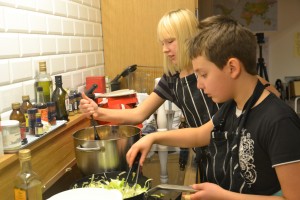
Preparing a meal.
Space for TioTretton was carved out of an adult library area in the Kulturhuset facility and renovated with funds from the city. Like Stockholm’s other libraries, its operations are fully supported by taxpayer money. Planning this new space, Hoflin was adamant that it have a kitchen, and that the architect needed to make the most of the large windows. She also wanted “a place to climb—this idea that kids could curl up with a book and grow,” says Stenberg. While Ortiz contemplated these goals within the 1,200-plus-square-foot space, he kept in mind the ideas of Danish philosopher and family therapist Jesper Juul, author of Your Competent Child: Toward a New Paradigm in Parenting and Education (English translation; Farrar, Straus; 2001). Ortiz says, “A child will do exactly what you want if you present it in a way that suits him. It’s a matter of how you present a problem.” Ortiz also wanted every library activity to circle back to reading. “The whole idea is to create a space where you catch their attention and give them a book,” he says. But kids had to lead the way: “The more you push, the less they will read in the future.” His design embodies his conviction that “everything is a progression of the mood of the child.”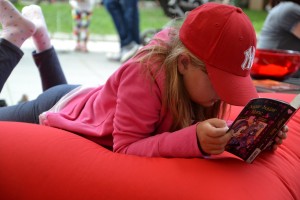
Sinking into the soft furniture with a book.
“If you are an introvert, you go to the cocoons,” he says, referring to hammock-like seating slung at varying heights next to the plate-glass windows that meet Hoflin’s request for a place to climb and curl up with a book. “You sit there and you don’t mingle.” Nestled in a cocoon by the large windows, a child “can see in and be protected at the same time.” However, “If you feel more open, you can sit on a red soft furniture area” constructed like stairs that ascend pyramid-style, Ortiz says. “I’ve carved little spaces inside this foamy area for similar reasons—for a child to find protection, look out, and mingle, but not too much.” “If he feels a bit playful he will find a soft ‘sausage’ seating area in the middle of the room where he can sink in,” Ortiz says. The activity areas always have themed books nearby as well. All of this makes TioTretton “not just a place with books. It’s a place to be well. Once a child had found a place to sit and be well, he is receptive to reading.” “If I go on this idea from introvert to extrovert,” Ortiz continues, “the more extroverted part of the design is this funky little bar outside the theater.” He is referring to a long, curved bar outfitted with red bar stools, like a bar you might find in a restaurant, near a stage area. He adds, “the whole design is done in concave and convex shapes. The concave shape has a bit of an introvert feeling, and the convex shape is more extroverted.”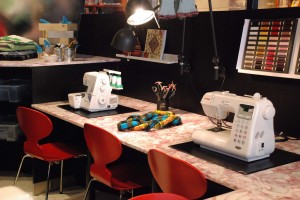
The Tio Tretton sewing area.
Acting as “third adults,” from cooking to crochet While Tio Tretton’s design empowers kids to discover their own experiences, its staff strives to make them feel un-pressured and free. Spending time in the kitchen meets many of those goals, says Stenberg. Hoflin “was very clear” about why the library needed a kitchen, she recalls. “The library should be a place where you could smell fresh cinnamon buns when you are reading.” The right smells, tactile features, and visual elements would contribute to a “library that should evoke all kinds of emotions.” In a kitchen, Stenberg adds, people “sit down and talk together and eat and share stories.” Concocting recipes at the large kitchen table, kids can experiment and make mistakes without consequences. “At this age, kids are thinking about performance and that things should be perfect,” Stenberg says. “The kitchen is a place to mix things and see what happens. They can put whatever they want in the ravioli.” Here and elsewhere, librarians are trained in specific ways to be that “third adult” who is neither parent nor teacher. “We work so much on how we talk to our kids,” says Stenberg. “For example, we don’t use gender-specific pronouns. We don’t ask where they’re from. We try to create an atmosphere where they shape their own identities. A place where you can come and experience stories. We don’t ask people their names.” Out in the main library space, the librarians are present while also hanging back. “We sit with a book or crochet or draw something,” says Stenberg. “We try to let the kids take the initiative.” While refraining from making personal inquiries, “we ask questions regarding what they are doing” or what kids are reading, in order to engage with them. Being an anti-authority figure is useful in other ways too. Though Stenberg is an accomplished cook, “I’m not very good at music programs,” she says. But some tweens view her lack of experience as a plus. The young patrons usually do not want experts helping them with music and film, Stenberg says. “I sit down and learn with the kids. It creates an open atmosphere.”
Ladders provide access to window seats with a city view. Photo © Ricardo Ortiz.
At its heart, TioTretton is “very organic,” notes Stenberg. “One of the biggest things is the philosophy that this is a work in progress that will never be finished. We should always try new things. TioTretton should shape and reshape itself.” It has already done so. When the library opened, “we had this idea that the more grownups in the library, the better,” she says. “It was too messy. We started too many projects at the same time.” During school visits, for instance, librarians used to host “really long digital and drama workshops.” The kids would look at the cocoons by the windows and say, “Can we just climb up there and read?” What happens when children age out of the library? Kids can start visiting TioTretton during the calendar year in which they turn 10, through the year they turn 14. Each January, “we have a lot of 9-year-old kids who have been waiting,” says Stenberg. At the other end, young teens who’ve had the freedom to start growing up at TioTretton “might feel that this library is not as much for them anymore.” By 14, they are usually ready to move on. “They’ve changed so much,” she says.RELATED
The job outlook in 2030: Librarians will be in demand
The job outlook in 2030: Librarians will be in demand
ALREADY A SUBSCRIBER? LOG IN
We are currently offering this content for free. Sign up now to activate your personal profile, where you can save articles for future viewing





Add Comment :-
Comment Policy:
Comment should not be empty !!!
Kathy Dempsey
I visited the Kulturhuset and its libraries last year, and they were amazing. Of course, I couldn't get past the door of this 'tween library, but knew that if it was anything like the others in the building, it would be spectacular. Thanks for the glimpse inside -- and the POV to inspire other librarians to think about how to *seriously* engage youth, beyond giving them their own small glass-walled rooms and basic collections. These Swedish kids will grow up feeling that libraries are essential to discovery and community, and so will be more apt to support them in adulthood.Posted : Dec 09, 2013 10:55